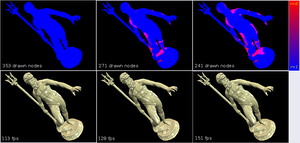Information
- Publication Type: PhD-Thesis
- Workgroup(s)/Project(s): not specified
- Date: December 2008
- Date (End): 2008
- TU Wien Library:
- Second Supervisor: Eduardo Romero
- Rigorosum: 20. February 2008
- First Supervisor: Michael Wimmer
Abstract
In order to achieve interactive rendering of complex models comprising several millions of polygons, the amount of processed data has to be substantially reduced. Level-ofdetail (LOD) methods allow the amount of data sent to the GPU to be aggressively reduced at the expense of sacrificing image quality. Hierarchical level-of-detail (HLOD) methods have proved particularly capable of interactive visualisation of huge data sets by precomputing levels-of-detail at different levels of a spatial hierarchy. HLODs support out-of-core algorithms in a straightforward way and allow an optimal balance between CPU and GPU load during rendering. Occlusion culling represents an orthogonal approach for reducing the amount of rendered primitives. Occlusion culling methods aim to quickly cull the invisible part of the model and render only its visible part. Most recent methods use hardware occlusion queries (HOQs) to achieve this task. The effects of HLODs and occlusion culling can be successfully combined. Firstly, nodes which are completely invisible can be culled. Secondly, HOQ results can be used for visible nodes when refining an HLOD model; according to the degree of visibility of a node and the visual masking perceptual phenomenon, then it could be determined that there would be no gain in the final appearance of the image obtained if the node were further refined. In the latter case, HOQs allow more aggressive culling of the HLOD hierarchy, further reducing the amount of rendered primitives. However, due to the latency between issuing an HOQ and the availability of its result, the direct use of HOQs for refinement criteria cause CPU stalls and GPU starvation. This thesis introduces a novel error metric, taking visibility information (gathered from HOQs) as an integral part of refining an HLOD model, this being the first approach within this context to the best of our knowledge. A novel traversal algorithm for HLOD refinement is also presented for taking full advantage of the introduced HOQ-based error metric. The algorithm minimises CPU stalls and GPU starvation by predicting HLOD refinement conditions using spatio-temporal coherence of visibility. Some properties of the combined approach presented here involve improved performance having the same visual quality (whilst our occlusion culling technique still remained conservative). Our error metric supports both polygon-based and point-based HLODs, ensuring full use of HOQ results (our error metrics take full advantage of the information gathered in HOQs). Our traversal algorithm makes full use of the spatial and temporal coherency inherent in hierarchical representations. Our approach can be straightforwardly implemented.Additional Files and Images
Weblinks
No further information available.BibTeX
@phdthesis{charalambos-thesis_hlod,
title = "HLOD Refinement Driven by Hardware Occlusion Queries",
author = "Jean Pierre Charalambos",
year = "2008",
abstract = "In order to achieve interactive rendering of complex models
comprising several millions of polygons, the amount of
processed data has to be substantially reduced.
Level-ofdetail (LOD) methods allow the amount of data sent
to the GPU to be aggressively reduced at the expense of
sacrificing image quality. Hierarchical level-of-detail
(HLOD) methods have proved particularly capable of
interactive visualisation of huge data sets by precomputing
levels-of-detail at different levels of a spatial hierarchy.
HLODs support out-of-core algorithms in a straightforward
way and allow an optimal balance between CPU and GPU load
during rendering. Occlusion culling represents an orthogonal
approach for reducing the amount of rendered primitives.
Occlusion culling methods aim to quickly cull the invisible
part of the model and render only its visible part. Most
recent methods use hardware occlusion queries (HOQs) to
achieve this task. The effects of HLODs and occlusion
culling can be successfully combined. Firstly, nodes which
are completely invisible can be culled. Secondly, HOQ
results can be used for visible nodes when refining an HLOD
model; according to the degree of visibility of a node and
the visual masking perceptual phenomenon, then it could be
determined that there would be no gain in the final
appearance of the image obtained if the node were further
refined. In the latter case, HOQs allow more aggressive
culling of the HLOD hierarchy, further reducing the amount
of rendered primitives. However, due to the latency between
issuing an HOQ and the availability of its result, the
direct use of HOQs for refinement criteria cause CPU stalls
and GPU starvation. This thesis introduces a novel error
metric, taking visibility information (gathered from HOQs)
as an integral part of refining an HLOD model, this being
the first approach within this context to the best of our
knowledge. A novel traversal algorithm for HLOD refinement
is also presented for taking full advantage of the
introduced HOQ-based error metric. The algorithm minimises
CPU stalls and GPU starvation by predicting HLOD refinement
conditions using spatio-temporal coherence of visibility.
Some properties of the combined approach presented here
involve improved performance having the same visual quality
(whilst our occlusion culling technique still remained
conservative). Our error metric supports both polygon-based
and point-based HLODs, ensuring full use of HOQ results (our
error metrics take full advantage of the information
gathered in HOQs). Our traversal algorithm makes full use of
the spatial and temporal coherency inherent in hierarchical
representations. Our approach can be straightforwardly
implemented.",
month = dec,
address = "Favoritenstrasse 9-11/E193-02, A-1040 Vienna, Austria",
school = "Institute of Computer Graphics and Algorithms, Vienna
University of Technology ",
URL = "https://www.cg.tuwien.ac.at/research/publications/2008/charalambos-thesis_hlod/",
}


 paper
paper
